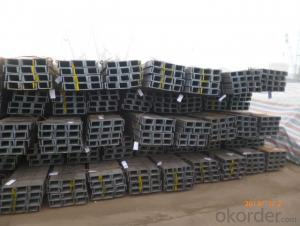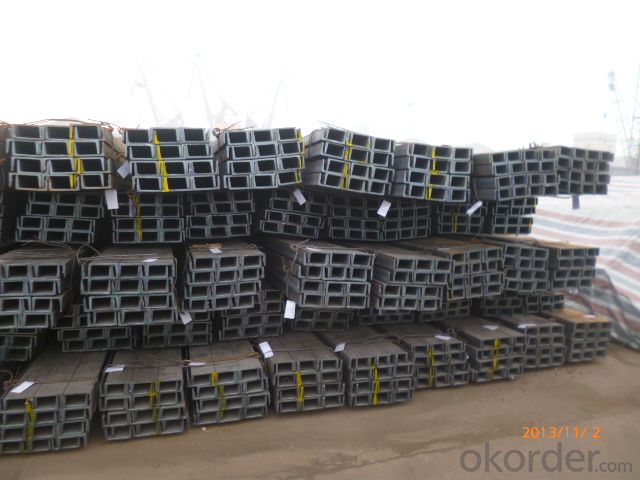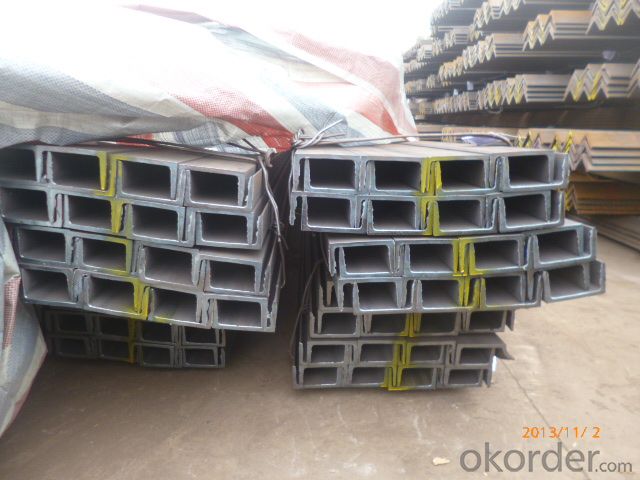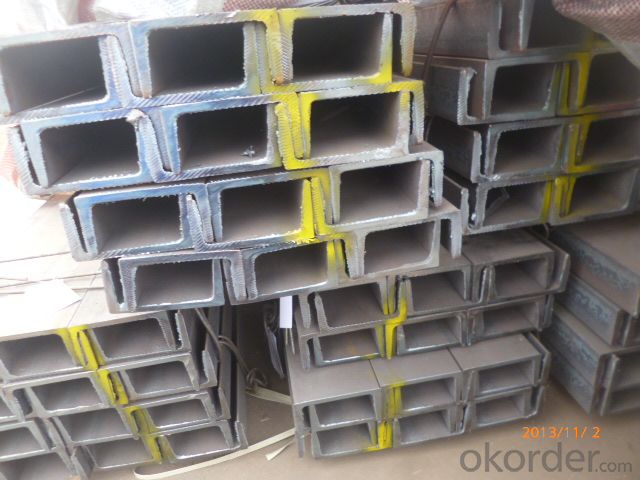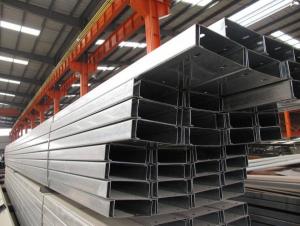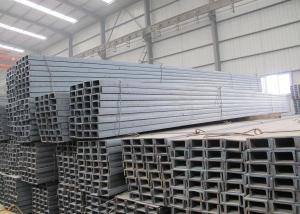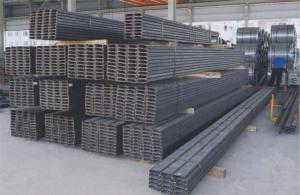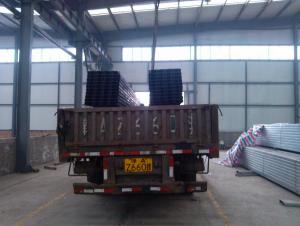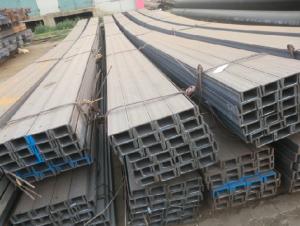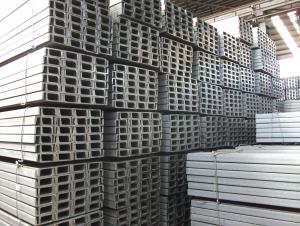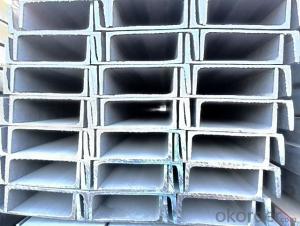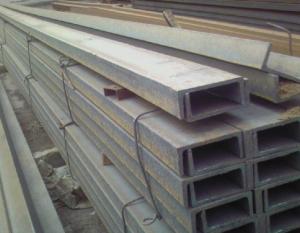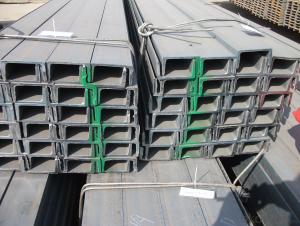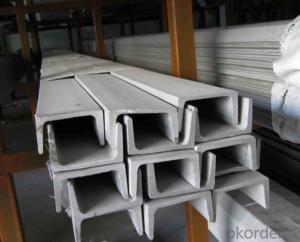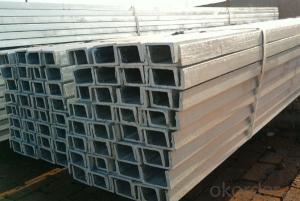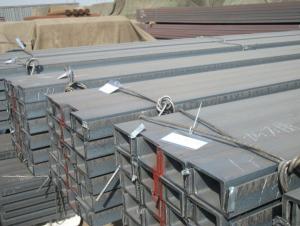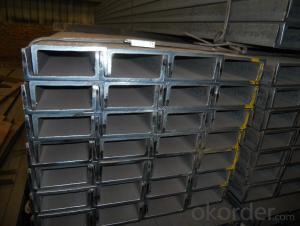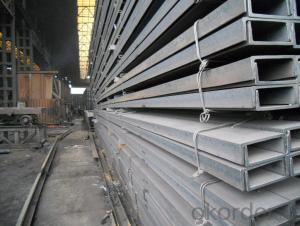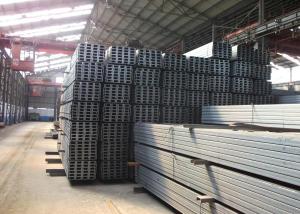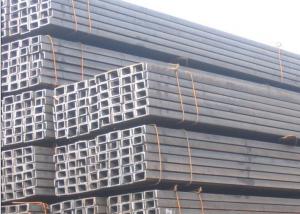JIS U-Channels Hot Rolled with High Quality
- Loading Port:
- Tianjin
- Payment Terms:
- TT OR LC
- Min Order Qty:
- 25 m.t
- Supply Capability:
- 10000 m.t/month
OKorder Service Pledge
OKorder Financial Service
You Might Also Like
Specification
OKorder is offering U-channels at great prices with worldwide shipping. Our supplier is a world-class manufacturer of steel, with our products utilized the world over. OKorder annually supplies products to European, North American and Asian markets. We provide quotations within 24 hours of receiving an inquiry and guarantee competitive prices.
Product Applications:
Japanese Standard U-channels are ideal for structural applications and are widely used in the construction of buildings and bridges, and the manufacturing, petrochemical, and transportation industries.
Product Advantages:
OKorder's Japanese Standard U-channels are durable, strong, and resist corrosion.
Main Product Features:
· Premium quality
· Prompt delivery & seaworthy packing (30 days after receiving deposit)
· Corrosion resistance
· Can be recycled and reused
· Mill test certification
· Professional Service
· Competitive pricing
Product Specifications:
Manufacture: Hot rolled
Grade: Q235/SS400
Certificates: ISO, SGS, BV, CIQ
Length: 6m – 12m, as per customer request
Packaging: Export packing, nude packing, bundled
1. We are definitely speciallizing in manufacturing and supplying channel steel as per japanese standard, which is characterised with high mechanical strength and competitive prices.
Original Place | Tangshan, China | Brand Name | UINDA |
Standard | JIS G3192 : 1990 | ||
Material Grade | SS400 | ||
Sizes | 50mm to 200mm | ||
Sales Volume/Year | 3000MT | ||
Destination Area | Middle East, Africa, Southeast Asia | ||
2. The sections in details are as followings in the table-1
JIS U CHANNEL | Standard | Sectional | Dimension |
| Mass: |
(mm) | (mm) | (mm) | (mm) | ||
50x25 | 50 | 25 | 3.0 | 6.00 | 2.37 |
75X40 | 75 | 40 | 3.8 | 7.00 | 5.30 |
75X40 | 75 | 40 | 4.0 | 7.00 | 5.60 |
75X40 | 75 | 40 | 4.5 | 7.00 | 5.85 |
75X40 | 75 | 40 | 5.0 | 7.00 | 6.92 |
100X50 | 100 | 50 | 3.8 | 6.00 | 7.30 |
100X50 | 100 | 50 | 4.2 | 6.00 | 8.03 |
100X50 | 100 | 50 | 4.5 | 7.50 | 8.97 |
100X50 | 100 | 50 | 5.0 | 7.50 | 9.36 |
125X65 | 125 | 65 | 5.2 | 6.80 | 11.66 |
125X65 | 125 | 65 | 5.3 | 6.80 | 12.17 |
125X65 | 125 | 65 | 5.5 | 8.00 | 12.91 |
125X65 | 125 | 65 | 6.0 | 8.00 | 13.40 |
150x75 | 150 | 75 | 5.5 | 7.30 | 14.66 |
150x75 | 150 | 75 | 5.7 | 10.00 | 16.71 |
150x75 | 150 | 75 | 6.0 | 10.00 | 17.90 |
150x75 | 150 | 75 | 6.5 | 10.00 | 18.60 |
150x75 | 150 | 75 | 6.5 | 10.00 | 24.00 |
200X80 | 200 | 80 | 7.5 | 11.00 | 24.60 |
Table-1
3. The mechanical property of JIS U Channel Steel in the table-2:
Grade | Yield Strength,N/mm² | Extension Strength N/mm² | |||
Thickness of Steel,mm | |||||
≦16 | >16-≦40 | >40-≦100 | >100 | ||
SS400 | ≧285 | ≧275 | ≧255 | ≧245 | 490-610 |
Table-2
4. The chemical composition of JIS U Channel Steel as per SS400 in the table-3
Grade | Element(%) | |||
C | Mn | P | S | |
SS400 | - | - | ≦0.050 | ≦0.050 |
Table-3
FAQ:
Q1: Why buy Materials & Equipment from OKorder.com?
A1: All products offered byOKorder.com are carefully selected from China's most reliable manufacturing enterprises. Through its ISO certifications, OKorder.com adheres to the highest standards and a commitment to supply chain safety and customer satisfaction.
Q2: How do we guarantee the quality of our products?
A2: We have established an advanced quality management system which conducts strict quality tests at every step, from raw materials to the final product. At the same time, we provide extensive follow-up service assurances as required.
Q3: The products are invoicing on theoritical weight or on actual weight?
A3: We can do it in both manners, according to the customers' request.
Images:
- Q: How do you calculate the section modulus for steel channels?
- In order to determine the section modulus of steel channels, one must take into account the geometric properties of the channel's cross-section. The section modulus, which measures a shape's ability to resist bending, is instrumental in determining the channel's strength and stiffness. To calculate the section modulus of a steel channel, utilize the following formula: Z = (b * h^2) / 6 In this equation, Z represents the section modulus, b refers to the channel's width, and h denotes the channel's height. Begin by measuring the width and height of the steel channel. The width typically corresponds to the distance between the flanges, while the height pertains to the dimension perpendicular to the flanges. Subsequently, insert the values of b and h into the formula and compute the section modulus. The outcome will provide a value indicative of the steel channel's resistance to bending. Generally, a higher section modulus indicates a stronger and stiffer channel. It is important to acknowledge that section modulus calculations are grounded in assumptions of elastic behavior and linear stress distribution. For more precise outcomes, it is advisable to consult engineering design manuals or seek guidance from a structural engineer who can account for additional factors like material properties and loading conditions.
- Q: What are the different surface treatments available for steel channels?
- Some of the different surface treatments available for steel channels include galvanizing, powder coating, painting, and epoxy coating. Galvanizing involves applying a protective layer of zinc to the surface of the steel, providing corrosion resistance. Powder coating involves applying a dry powder to the surface of the steel, which is then heated and cured to create a durable and decorative coating. Painting involves applying liquid paint to the steel surface, providing both protection and aesthetics. Epoxy coating involves applying an epoxy resin to the steel surface, which creates a durable and chemically resistant coating.
- Q: Are steel channels suitable for data center construction?
- Yes, steel channels are suitable for data center construction. Steel channels, also known as C-channels, provide strength, stability, and flexibility required for constructing data centers. They are often used as framing elements for walls, ceilings, and floors due to their durability and ability to withstand heavy loads. Steel channels offer several advantages for data center construction. Firstly, they have excellent load-bearing capabilities, allowing them to support the weight of server racks, equipment, and infrastructure. This is crucial in data centers where the equipment density is high, and the weight of servers and networking devices can be significant. Moreover, steel channels provide structural stability, ensuring that the data center remains secure and robust. They are resistant to bending and buckling, providing a solid framework that can withstand both internal and external forces. This is particularly important in regions prone to seismic activities or extreme weather conditions. Additionally, steel channels can easily accommodate the installation of various utilities required in data centers, such as electrical wiring, cable trays, and cooling systems. They can be designed with pre-punched holes or slots, making it convenient to route cables and pipes throughout the facility. Furthermore, steel channels offer versatility in design and construction. They can be easily modified and adjusted to meet specific layout requirements, allowing for efficient use of space and flexibility in future expansions or modifications. This adaptability is essential in data centers where technology and infrastructure needs are constantly evolving. In summary, steel channels are indeed suitable for data center construction. Their strength, stability, flexibility, and versatility make them an ideal choice for creating a robust and efficient infrastructure to support the critical operations of a data center.
- Q: Are steel channels resistant to pests and termites?
- Yes, steel channels are resistant to pests and termites as they are made from a non-organic material that does not attract or provide food for these nuisances.
- Q: What are the different methods of finishing steel channels?
- There are several methods of finishing steel channels, each with its own unique characteristics and benefits. Some of the most common methods include: 1. Hot-dip galvanizing: This process involves immersing the steel channels in a bath of molten zinc. The zinc coating provides excellent corrosion resistance, making it ideal for outdoor applications. Hot-dip galvanizing also creates a durable and long-lasting finish. 2. Powder coating: Powder coating involves applying a dry powder to the steel channels and then curing it under heat. This method provides a thick and even coating that is highly resistant to chipping, scratching, and fading. Powder coating is available in a wide range of colors and finishes, allowing for customization. 3. Paint coating: Steel channels can also be finished with various types of paint coatings. These coatings provide both aesthetic appeal and protection against corrosion. Paint coatings can be applied using spray guns, brushes, or rollers, and they offer flexibility in terms of color and texture. 4. Electroplating: Electroplating is a process in which a thin layer of metal, such as chrome or nickel, is bonded to the steel channels through an electrochemical reaction. This method enhances the appearance of the steel channels, providing a decorative and lustrous finish. Electroplating can also improve the corrosion resistance of the steel. 5. Anodizing: Anodizing is primarily used for finishing aluminum channels but can also be used on steel channels. It involves creating an oxide layer on the surface of the metal through an electrochemical process. Anodized steel channels have increased corrosion resistance, improved hardness, and can be dyed in various colors. 6. Mechanical finishes: Mechanical finishes are achieved through processes such as grinding, polishing, or brushing. These finishes alter the surface texture of the steel channels, creating a specific appearance or removing imperfections. Mechanical finishes can range from a smooth and glossy look to a matte or textured finish. Overall, the choice of finishing method for steel channels depends on the desired appearance, level of corrosion resistance, and the specific application requirements. Each method offers its own advantages and considerations, enabling manufacturers and end-users to select the most suitable finish for their needs.
- Q: What are the different types of steel channel connections for floor framing?
- For floor framing, there exist various types of connections for steel channels. 1. Welded Connections: The most commonly used connection for steel channel floor framing is welding. This involves welding the channels at the joints, resulting in a robust and long-lasting connection. Welded connections are suitable for heavy loads and high levels of vibration. 2. Bolted Connections: Another option is using bolts to connect the channels. This type of connection allows for easy disassembly and reassembly, making it ideal for situations where modifications or relocation may be necessary. Bolted connections are also more cost-effective than welded connections and can handle lighter loads. 3. Riveted Connections: Riveted connections involve using rivets instead of bolts to connect the channels. This type of connection offers a strong and secure bond and is often preferred for its traditional or aesthetic appearance. 4. Clip Connections: Clip connections involve using clips or brackets to hold the channels together. This type of connection is quick and easy to install and does not require welding or drilling. Clip connections are commonly used when quick assembly or potential future disassembly is desired. 5. Moment Connections: Moment connections are suitable when the channels need to resist bending moments or torsion. These connections provide a rigid bond between the channels, enabling effective load transfer. Moment connections are more complex and require meticulous design and installation. In summary, the choice of steel channel connection for floor framing depends on factors such as load requirements, project specifications, and budget. It is advisable to seek guidance from a structural engineer or professional to determine the most suitable connection type for your specific application.
- Q: No. 8 at No. 6 steel, how much is the channel size
- The dimensions are eighty cm and sixty cm
- Q: What are the different types of steel channel sections?
- In construction and engineering applications, various steel channel sections are commonly utilized. Some of the frequently used types are as follows: 1. C-channel: Employed for structural support and framing in construction projects, this steel channel features a C-shaped cross section. 2. U-channel: For applications demanding strength and rigidity, such as bridge and building construction, this steel channel with a U-shaped cross section is often chosen. 3. Hat channel: Also referred to as a furring channel, this steel channel has a hat-shaped cross section and is commonly used in the construction industry to attach drywall or other materials to walls and ceilings. 4. Z-channel: In scenarios where there is a need to join two pieces of material, like metal roofs or walls in construction, this steel channel with a Z-shaped cross section is commonly employed. 5. Box channel: This steel channel, with a square or rectangular cross section, is frequently used when a high strength-to-weight ratio is required, such as in the construction of bridges or support beams. These examples illustrate only a few of the available steel channel section types. The selection of the specific steel channel depends on the project's requirements and the desired strength and rigidity of the structure.
- Q: Can steel channels be customized according to specific requirements?
- Indeed, specific requirements can be accommodated through the customization of steel channels. In the construction and manufacturing industries, steel channels find widespread use for framing, support, and reinforcement purposes. These channels can be tailored to meet precise project specifications in terms of size, shape, length, thickness, and material composition. By customizing steel channels, a higher degree of flexibility and adaptability can be achieved in diverse applications. For example, the channel's dimensions and form can be modified to align with specific structural designs or to withstand particular loads and stresses. The channel's length can be personalized to suit the project's dimensions, while the thickness can be adjusted to provide the desired strength and durability. Moreover, material composition is another aspect that can be customized for steel channels. Depending on the project's requirements, various steel types, including carbon steel, stainless steel, or alloy steel, can be employed. This customization ensures that the steel channel possesses the necessary properties, such as corrosion resistance, heat resistance, or high tensile strength, to successfully endure the intended application. In summary, steel channels can undoubtedly be customized to cater to specific requirements, offering a versatile solution for a wide range of construction and manufacturing needs.
- Q: Many of the equipment in the substation is installed on the support of the channel, why not directly mounted on the support plate. Why should we add channel steel to the top plate?What effect can this channel play?
- The bottom of the switch cabinet is easy to screw with the base steel parts, and the grounding is good;
Send your message to us
JIS U-Channels Hot Rolled with High Quality
- Loading Port:
- Tianjin
- Payment Terms:
- TT OR LC
- Min Order Qty:
- 25 m.t
- Supply Capability:
- 10000 m.t/month
OKorder Service Pledge
OKorder Financial Service
Similar products
Hot products
Hot Searches
Related keywords
